人教版(2019)必修 第二册Unit 1 Cultural Heritage Assessing Your Progress & Video Time(共16张,内嵌视频)
文档属性
| 名称 | 人教版(2019)必修 第二册Unit 1 Cultural Heritage Assessing Your Progress & Video Time(共16张,内嵌视频) | 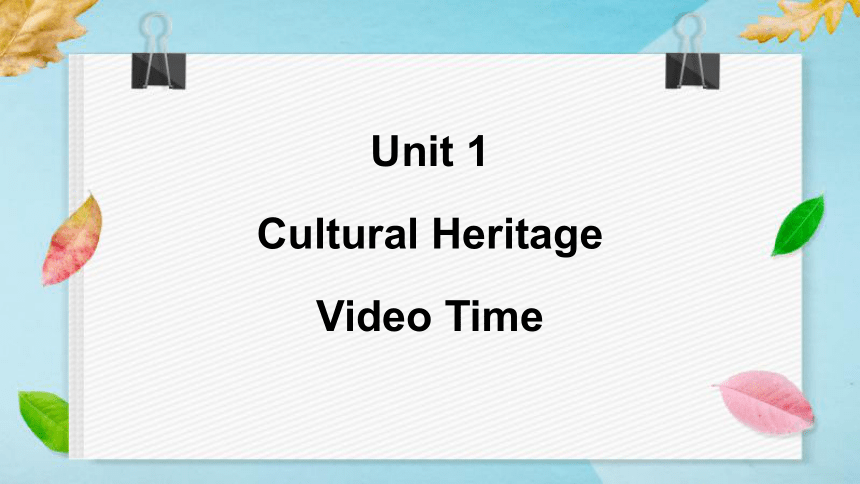 | |
| 格式 | pptx | ||
| 文件大小 | 48.4MB | ||
| 资源类型 | 教案 | ||
| 版本资源 | 人教版(2019) | ||
| 科目 | 英语 | ||
| 更新时间 | 2025-01-13 23:07:55 | ||
图片预览

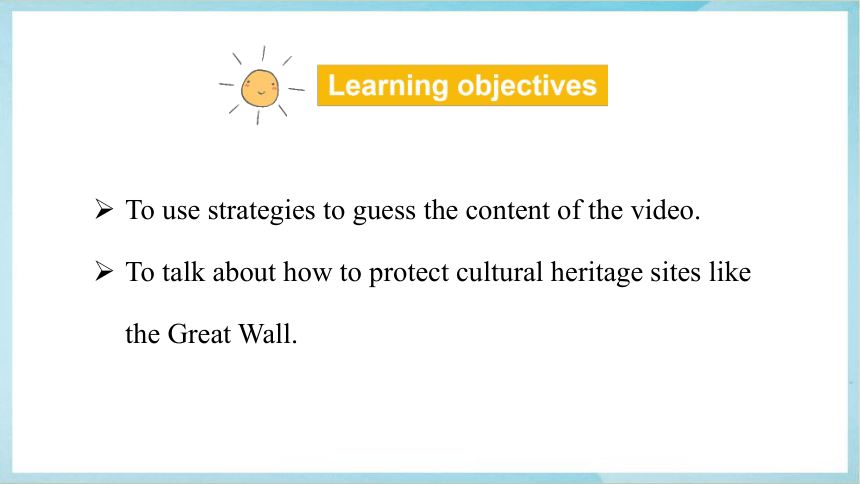
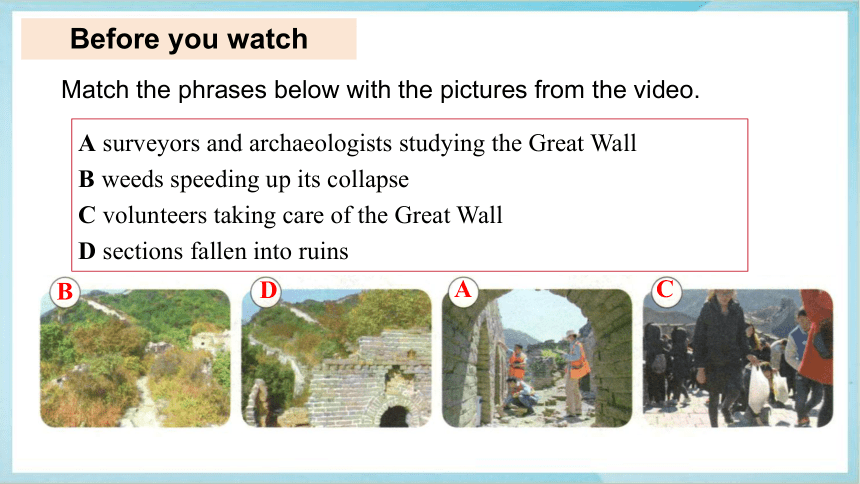
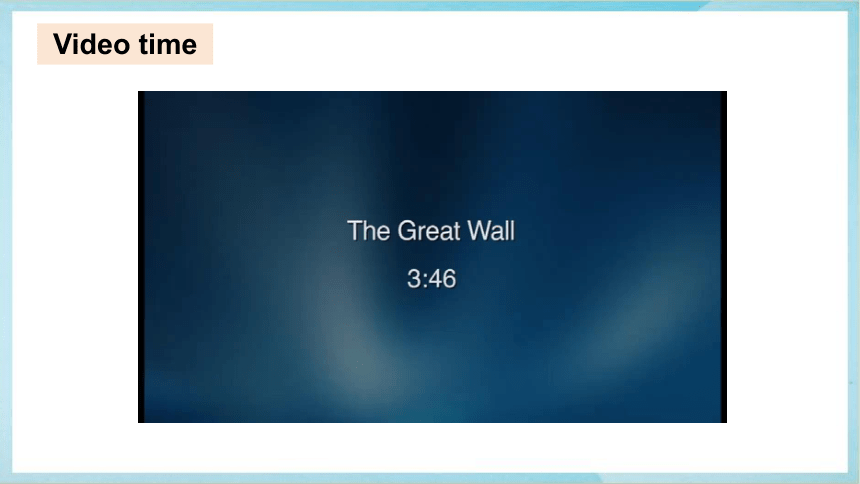
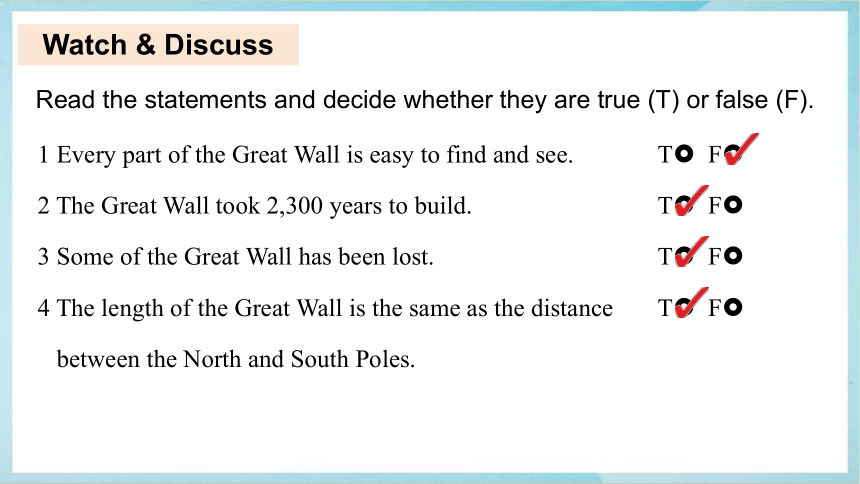
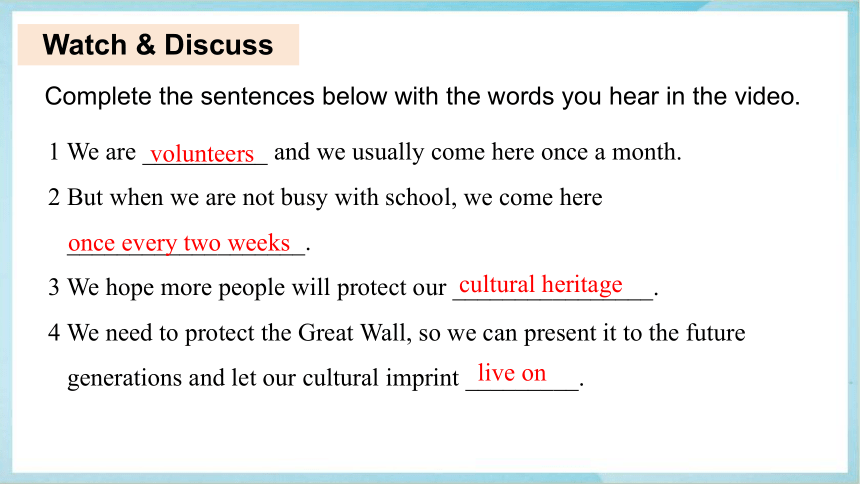
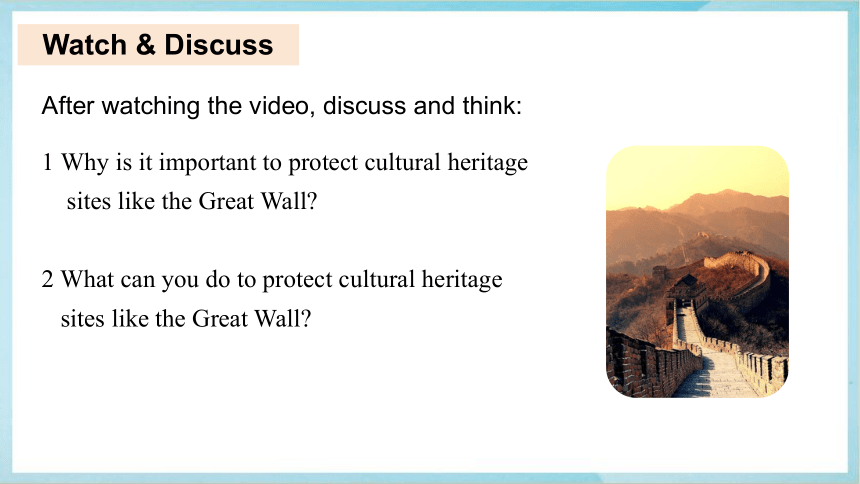
文档简介
(共16张PPT)
Unit 1
Cultural Heritage
Video Time
To use strategies to guess the content of the video.
To talk about how to protect cultural heritage sites like the Great Wall.
Match the phrases below with the pictures from the video.
A surveyors and archaeologists studying the Great Wall
B weeds speeding up its collapse
C volunteers taking care of the Great Wall
D sections fallen into ruins
B
D
A
C
Before you watch
Video time
1 Every part of the Great Wall is easy to find and see.
2 The Great Wall took 2,300 years to build.
3 Some of the Great Wall has been lost.
4 The length of the Great Wall is the same as the distance
between the North and South Poles.
T F
T F
T F
T F
Read the statements and decide whether they are true (T) or false (F).
Watch & Discuss
Complete the sentences below with the words you hear in the video.
1 We are __________ and we usually come here once a month.
2 But when we are not busy with school, we come here
___________________.
3 We hope more people will protect our ________________.
4 We need to protect the Great Wall, so we can present it to the future
generations and let our cultural imprint _________.
volunteers
once every two weeks
cultural heritage
live on
Watch & Discuss
After watching the video, discuss and think:
1 Why is it important to protect cultural heritage
sites like the Great Wall
2 What can you do to protect cultural heritage
sites like the Great Wall
Watch & Discuss
How can you take part in cultural heritage protection
Read the passage. Then complete the phrases below and use them to finish the passage.
in to from a balance sure
be proud ______ keep _________ prevent_______
donate sth ______ lead _______ take part ______
make ______ turn _______
in
to
from
a balance
to
in
to
sure
Learn & Think
Getting young people to ___________ activities to protect their national heritage is a good way to introduce them to their country’s history. As they learn more about where they come from, they will hopefully __________ tell others about their country and culture. Of course, teachers must _____________ between teaching the good and bad parts of a country’s history. Learning only the good parts can ________ narrow thinking. Learning the bad parts may help _________ those kinds of things _______ happening again.
take part in
be proud to
keep a balance
lead to
prevent
from
Passage:
Learn & Think
Students who know their history and culture are more likely to __________ that their cultural heritage is protected, and teachers can motivate students by asking them to come up with their own ideas and make proposals for ways to protect this. One possible idea is for students to raise or ________ money _____ an organisation or group that protects their country’s cultural heritage. Teachers may also ________ their local museums or historical societies for help in getting students more interested in this important field.
make sure
donate
to
turn to
Passage:
Learn & Think
A: My teacher just gave us a task __________ I really don’t know how
to do. I have to take part in an organisation __________ protects
our cultural heritage.
B: Oh, that sounds interesting! Where are you planning to go I’m sure
there are all kinds of historic sites ____________ cultural relics need
to be protected.
that/which
that/which
where/whose
Read the conversation and learn about intangible cultural heritage(ICH). Then complete it with the correct relative pronouns or adverbs.
Learn & Think
A: Yes, but I’m not one of those people ______ love museums. I think
they’re kind of boring. I like going on field trips _______ I can
experience and do things to protect cultural relics.
B: Cultural heritage is a lot more than just relics, you know. For example,
our country has many nationalities ______ dances, crafts, and other
traditions are also very important. If we don’t protect those traditions,
there may come a time ______ they disappear.
who
where
whose
when
Read the conversation and learn about intangible cultural heritage(ICH). Then complete it with the correct relative pronouns or adverbs.
Learn & Think
The Great Wall is a cultural heritage. Temples, palaces and other relics are a country’s cultural heritage. But how about traditions, customs and knowledge, such as dances, crafts Are they cultural heritage
Discuss
(1) Are you familiar with them
(2) What kind of cultural heritage are they
(3) Do you want to take part in one of them Why
(4) What other kinds of ICH do you know
(5) What problems are these kind of ICH facing
(6) How can we protect ICH in China Or what are your solutions
Work in pairs and look at the examples of Chinese ICH. Discuss the questions:
Discuss
选择一项非物质文化项目,制作海报,包括:
(1)价值与意义
(2)面临的问题
(3)你希望的保护措施
It’s Your Turn
Assignment
Polish your poster.
Unit 1
Cultural Heritage
Video Time
To use strategies to guess the content of the video.
To talk about how to protect cultural heritage sites like the Great Wall.
Match the phrases below with the pictures from the video.
A surveyors and archaeologists studying the Great Wall
B weeds speeding up its collapse
C volunteers taking care of the Great Wall
D sections fallen into ruins
B
D
A
C
Before you watch
Video time
1 Every part of the Great Wall is easy to find and see.
2 The Great Wall took 2,300 years to build.
3 Some of the Great Wall has been lost.
4 The length of the Great Wall is the same as the distance
between the North and South Poles.
T F
T F
T F
T F
Read the statements and decide whether they are true (T) or false (F).
Watch & Discuss
Complete the sentences below with the words you hear in the video.
1 We are __________ and we usually come here once a month.
2 But when we are not busy with school, we come here
___________________.
3 We hope more people will protect our ________________.
4 We need to protect the Great Wall, so we can present it to the future
generations and let our cultural imprint _________.
volunteers
once every two weeks
cultural heritage
live on
Watch & Discuss
After watching the video, discuss and think:
1 Why is it important to protect cultural heritage
sites like the Great Wall
2 What can you do to protect cultural heritage
sites like the Great Wall
Watch & Discuss
How can you take part in cultural heritage protection
Read the passage. Then complete the phrases below and use them to finish the passage.
in to from a balance sure
be proud ______ keep _________ prevent_______
donate sth ______ lead _______ take part ______
make ______ turn _______
in
to
from
a balance
to
in
to
sure
Learn & Think
Getting young people to ___________ activities to protect their national heritage is a good way to introduce them to their country’s history. As they learn more about where they come from, they will hopefully __________ tell others about their country and culture. Of course, teachers must _____________ between teaching the good and bad parts of a country’s history. Learning only the good parts can ________ narrow thinking. Learning the bad parts may help _________ those kinds of things _______ happening again.
take part in
be proud to
keep a balance
lead to
prevent
from
Passage:
Learn & Think
Students who know their history and culture are more likely to __________ that their cultural heritage is protected, and teachers can motivate students by asking them to come up with their own ideas and make proposals for ways to protect this. One possible idea is for students to raise or ________ money _____ an organisation or group that protects their country’s cultural heritage. Teachers may also ________ their local museums or historical societies for help in getting students more interested in this important field.
make sure
donate
to
turn to
Passage:
Learn & Think
A: My teacher just gave us a task __________ I really don’t know how
to do. I have to take part in an organisation __________ protects
our cultural heritage.
B: Oh, that sounds interesting! Where are you planning to go I’m sure
there are all kinds of historic sites ____________ cultural relics need
to be protected.
that/which
that/which
where/whose
Read the conversation and learn about intangible cultural heritage(ICH). Then complete it with the correct relative pronouns or adverbs.
Learn & Think
A: Yes, but I’m not one of those people ______ love museums. I think
they’re kind of boring. I like going on field trips _______ I can
experience and do things to protect cultural relics.
B: Cultural heritage is a lot more than just relics, you know. For example,
our country has many nationalities ______ dances, crafts, and other
traditions are also very important. If we don’t protect those traditions,
there may come a time ______ they disappear.
who
where
whose
when
Read the conversation and learn about intangible cultural heritage(ICH). Then complete it with the correct relative pronouns or adverbs.
Learn & Think
The Great Wall is a cultural heritage. Temples, palaces and other relics are a country’s cultural heritage. But how about traditions, customs and knowledge, such as dances, crafts Are they cultural heritage
Discuss
(1) Are you familiar with them
(2) What kind of cultural heritage are they
(3) Do you want to take part in one of them Why
(4) What other kinds of ICH do you know
(5) What problems are these kind of ICH facing
(6) How can we protect ICH in China Or what are your solutions
Work in pairs and look at the examples of Chinese ICH. Discuss the questions:
Discuss
选择一项非物质文化项目,制作海报,包括:
(1)价值与意义
(2)面临的问题
(3)你希望的保护措施
It’s Your Turn
Assignment
Polish your poster.
